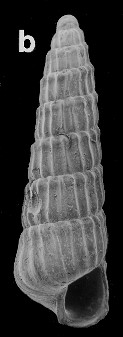
Revised descriptions of New Zealand Cenozoic Mollusca from Beu and Maxwell (1990)

 | Revised descriptions of New Zealand Cenozoic Mollusca from Beu and Maxwell (1990) | 
|
  (Pl. 57b): Turbonilla natales Laws, 1937; Slip Point, Clifden, Waiau River (Clifdenian) (ex C.R. Laws colln.) |
Beu & Maxwell (1990): Chapter 17; p. 390; pl. 57 b.
Classification: Pyramidellidae: Turbonillinae
Description: Height 3-9.8 mm, turriculate, spire typically very elevated. Protoconch helicoid or planorboid, of 1-2.5 whorls, apex in helicoid type protruding laterally in some species. Teleoconch whorls typically flat-sided to moderately convex, medially concave in some species; sculpture of axial costae of varying width, spacing and inclination, typically straight but arcuate in some species, intercostal spaces dying out gradually over base (not stopping abruptly at edge); no spiral sculpture. Aperture ovate, columella typically smooth or with weak posterior swelling, but some species with definite plait.
Comparison: Turbonilla differs from Chemnitzia in the nature of the intercostal spaces — these do not stop abruptly at the edge of the base, but die out gradually on the base. Pyrgolampros Sacco, 1892, Pyrgiscus Philippi, 1841 and Planpyrgiscus Laws, 1937 differ in having distinct spiral sculpture. Those species referred by Laws (1937c, p. 175-179) to Mormula A. Adams, 1864 differ from Turbonilla in having broad, low varices in addition to axial costae; some species also have spiral sculpture. They do not seem to be congeneric with M. rissoina A. Adams, 1864 — the type species — and require relocation.
Laws (1937a, b) subdivided both Turbonilla and Chemnitzia into two groups on the basis of the protoconch (i.e. whether it is planorboid or helicoid) and suggested that these groups are generically separable. However, it is now generally thought that such differences merely reflect differing types of larval development (i.e. lecithotrophic and planktotrophic respectively) and do not in themselves warrant supraspecific discrimination.
Most New Zealand species of Turbonilla have a smooth columella or one with a weak posterior swelling, but some (i.e. T. paleogenica, T. ngatapa and T. zesulcata) have a prominent plait. This may indicate either that these species are incorrectly assigned to Turbonilla, or that the primary basis for distinguishing between the Turbonillinae and Odostomiinae is of dubious value.
Distribution: Mangaorapan?, Bortonian-Recent, New Zealand; cosmopolitan, Eocene-Recent.
Cite this publication as: "A.G. Beu and J.I. Raine (2009). Revised
descriptions of New Zealand Cenozoic Mollusca from Beu and Maxwell (1990). GNS
Science miscellaneous series no. 27."
© GNS Science, 2009
ISBN
978-0-478-19705-1
ISSN 1177-2441
(Included with a PDF facsimile file
copy of New Zealand Geological Survey Paleontological Bulletin 58 in CD version
from: Publications Officer, GNS Science, P.O. Box 30368 Lower Hutt, New
Zealand)